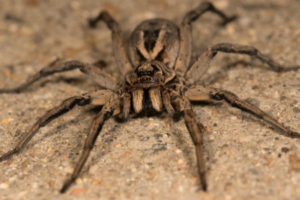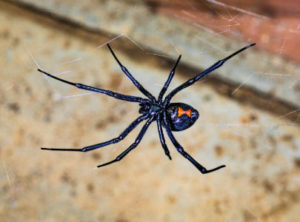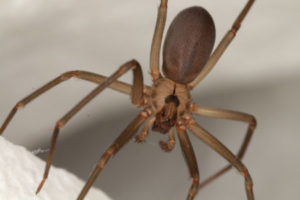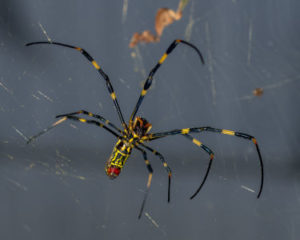Don’t Fear Most Spiders in New England
By Zachary Ciras on July 31, 2022.
In Massachusetts and New Hampshire, spiders are everywhere! In fact, worldwide they are everywhere! Worldwide, over 40,000 species of spiders have been identified and named, and likely more than three times that number are still yet to be named. In North America, around 3,700 species occur, but only a small portion of these actually are found in manmade structures. Even the most accomplished entomologists are not comfortable with the precision needed to identify the number of spiders we may randomly encounter. An arachnologist dedicates a lifetime of study and research to approach this task. The variation in anatomy and colors are so intricate and vast, one must have an appreciation for these creatures, and many also have a fear. Most of the spiders we encounter on a daily basis are less venomous or relatively harmless to humans, but we do have some spiders considered to be highly venomous. While the probability of getting bitten by a highly venomous spider in MA or NH is low, it’s good to know what to look for. See Also: Spiders in New Hampshire

Wolf spider
Arachnophobia is a fear of spiders stretching back past history, so no amount of reasoning will soon persuade those afflicted that they have little about which to worry. All too often, when a spot of redness occurs on someone and this is presented to a doctor, the doctor and the patient are very quick and easy to blame it on a spider. In truth, the likelihood of a spider bite is low. Spiders tend to only bite humans when they feel immediately threatened, such as when they are about to be crushed! And if bitten, these bites are usually harmless. Many doctoral pronouncements about spider bites are made without corroborating evidence, and should not be taken as a sign to “bomb” your home. See: Got a Bite? Don’t Blame it on a Spider The real over-the-counter insecticide/arachnicide is far more of a health hazard than the vast majority of any spiders you chance to encounter inside your home. So, what spiders are found in Massachusetts and New Hampshire? (SPIDERS ARE ACTIVE INDOORS YEAR ROUND)
Widow spiders

Black Widow Spider waiting for her prey
Okay, so there are technically some venomous spiders of note in New England. However, your chances of a deadly encounter are slim to none; see this report from UCONN Health. Keep in mind that these spiders with the highest toxicity are rare, and if they are encountered, they are very likely to hide from you rather than to bite. the two primary culprits of harmful spider bites in the United States are yeti Black Widow and the Brown Recluse. Both of these spiders are much more common in warmer climates, and when they are found in Massachusetts and New Hampshire, they were most likely stowaways from more southern states.
Black Widow
The Black Widow spider has a storied reputation in pop culture. The titular Marvel character is the latest iteration, bringing a perception of strength to the name. Historically, a Black Widow reference to a person denotes a sort of femme fatale. Despite their reputation, they are not the most poisonous spiders in the world. They are found in small numbers in Massachusetts and New Hamshire. Their shiny black 1/2″-2″ bodies have an orange or red dot on the back, and the females show their trademark red hourglass underneath. Thankfully, it has been decades since a reported death from a Black Widow, and some reported lethalities may be truly from other causes, such as this suggestion regarding a 1900 case. Symptoms of a Black Widow spider bite may last 1-3 days and consist of redness and swelling, abdominal pain and cramping reminiscent of appendicitis, and nausea, vomiting, tremors, and/or sweating. The treatment may be an IV antivenom administered by a doctor if needed.
Brown Widows are certainly less venomous and less likely to attack. They are smaller as well, typically 1/2″-1″ long, brown, and found primarily in the Southeastern US, California, and some tropical regions. True Widows, or Latrodectus, are found worldwide except for Antarctica.
False Black Widow
Many folks will observe a spider reminiscent of the storied Black Widow, though without the telltale makings. The body is also smaller, especially of the male, and more brown than shiny black. These are four indoors and outdoors in a variety of climates, and most bites will resemble a wasp sting.
Brown Recluse Spiders

Brown recluse spider. Violin spider.
The Brown Recluse spider body is usually 2/5″-.8″ long with 3/4″ legs extending from its paler brown body. One distinct marking on the Brown Recluse which sets it apart is the violin or fiddle marking on its back. Not native to any New England states, this spider is mostly active at night. As the name suggests, the 6 eyed arachnid hides in concealed places waiting fro prey. A bite might result in in increasing pain over the first eight hours, fever, chills, body aches, a wound with a pale center and blue or purple encircling it with red ring around it. Most alarmingly, skin necrosis around the would may cause ulceration, infection, and require surgery or antibiotics. In most cases, bites or irritations attributed to the Brown Recluse are of another spider, if a spider at all. One Independence Day weekend early in this technician’s early career was spend scouring a warehouse in the Worcester and Leicester area of Central Massachusetts for a reported Brown Recluse which a worker claimed to have attacked. The probability was low, but because the warehouse had recently received large shipments in cardboard from the American South, there was enough cause for concern to act. See: PROBABLY NOT A BROWN RECLUSE SPIDER BITE
New Invader?
Joro Spider

Joro spider, an invasive spider originating in Asia, now concentrated in Georgia, USA, and migrating north and west
The Joro Spider has been making its way quietly through the news in the last year or so, but it wouldn’t be hard to miss if seen in the wild. These web making spiders are a noticeable almost mean yellow and can grow about 4″ long, or about the size of your palm! Georgia has had confirmed reports of the spider since 2013, as has South Carolina, most likely brought in through shipping containers from Japan. Some experts estimate that Massachusetts may see the Joro spider in about 10 years, though only in the summers. This spider is not likely to be cause for concern in health or agriculture, but it will surely be alarming to find if it does.
Common Spider of Note
Wolf Spider
Another spider which is actively in Massachusetts and New Hampshire is the Wolf Spider. This large, furry spider is an alarming site for homeowners to see, especially if in great numbers. One infestation in Grafton, MA had dozens of wolf spiders calling the garage home. With the office situated above the garage, and a few sighting reported there, action was taken to neutralize the infestation and an ongoing preventative maintenance plan was instituted. See: It’s a Wolf Spider, Not a Tarantula
Yellow Sac Spider
This spider may be venomous, though studied have suggested both ends of concern, being highly worrisome to entirely forgettable. Any way, removing the small silk nests often at the ceiling and wall junctures should be removed and the area treated for prevention.
Cellar Spider
One of the most commonly reported spider pests in homes, these critters build ordinary nests and hang out waiting fro food. Basements, garages, hallways, bedrooms, vestibules, and just about any other area of the home can be an ideal environment for cellar spiders. Though not harmful to humans, the web building can be annoying and frustrating to deal with.
Daddy Long Legs
Technically, not a spider. These arachnids are in group called harvestmen, related to spider, but with a few key differences. Surprise! “Daddylonglegs” Are Not Spiders
Orb Weavers
This group of spiders containing many species of spiders creates beautiful webs. The spiders are among the most common and numerous wheel shaped webs, and are beautiful creatures up close. In fact, most spiders photographed with macro-photography are quite striking, with their rows of eyes and stunningly intricate colors.
Jumping Spiders
Another group of spiders widely available, but largely outside, are jumping spiders. Generally harmless, this group of spider is often found in grasses outside of the home, and can be very tiny and easy to miss.
Garden Spiders
Garden spiders are found often in the gardens of New England, or anywhere where plants grow and other insect eat. These predatory spiders are a benefit to many gardens, controlling the populations of insects who would otherwise damage crops.
Prevention and Remediation
Dehumidifiers are great pest control tools in a variety of situations against a number of pests, including spiders. If spiders are infesting your home in great numbers, they are present due to the abundance 0f food. See: GOT SPIDERS? THEN YOUR HOME IS PROVIDING SPIDER FOOD. One way to cut back on spider food, is to reduce the humidity which makes it so comfortable to the insects spiders consume to thrive. Reducing clutter, trimming vegetation away from the home, and cleaning out webs as you find them.
A comprehensive pest control program will help to keep the 8 legged creatures at bay. Our Preventative Maintenance Program applied twice per year at optimal times will provide a continuous barrier against pests including spiders, ants, wasps, and more. Spiders are generally not a major threat inside our homes, and many spiders are a net benefit to the ecosystem, but everything has its place and for many of us, spiders’ place is outside, not inside of our homes! Colonial can help.